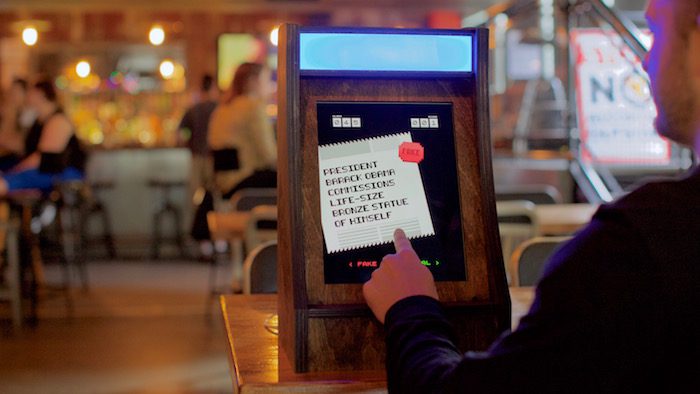
Want to create your own fake news? Yep, there’s an app for that.
Want to have fun while learning how to dump fake news from your media diet? Fortunately, there are a few apps for that too.
The epidemic of fake news during and after the U.S. presidential election convinced several game designers and journalists to think outside the box for trying to tackle the problem. They say that great minds think alike — and three different groups have created three similar apps to help users learn how to tell the difference between misleading headlines and factual claims.“Being politically aware in this day and age is exhausting,” said Christopher Cinq-Mars Jarvis, the developer of a game based on PolitiFact’s fact-checked claims. “Something to make it a little more accessible and rewarding helps. You can do it not only with politics, but with a variety of things.”
After the election, Jarvis was inspired to team up with PolitiFact to create the mobile game PolitiTruth. The Washington, D.C.-based digital creative agency ISL built Fake News: The Game and has introduced it as an app and a traveling arcade game in some bars. And Maggie Farley, a JoLT Fellow at American University and former L.A. Times correspondent, developed the concept of a fake news game with AU Game Lab director Lindsay Grace even before the election, though the lab recently released the 2.0 version of Factitious, a browser-based game heavy with context for its articles.
The games share roughly the same setup of presenting a player with a headline, article, or claim and asking them to guess its truthfulness. None of the items are made up — they’re all published online somewhere, either a website known for promoting fake news or an actual news organization’s site. Fake News: The Game only shows a headline, and Factitious includes a snippet of an article with a headline and a source if you choose to see it. (Factitious is an open source project developed with a Knight Foundation grant for gaming in journalism. Knight also supports Nieman Lab.) PolitiTruth draws from PolitiFact’s bounty of factchecked claims to give you a quote, the name of the public figure who said it, and the context of when/where they said it, and asks you to guess the veracity of the claim made in the quote. You get points for correctness and in some games that translates to a global leaderboard.
Are they as addictive as Pokemon Go or Candy Crush? That’s the hope.
“The global pandemic of misinformation is obviously unavoidable and real, and if we can play a small, small role in pushing back against that, then we’re excited and thrilled to help fight the good fight,” said D.J. Saul, ISL’s chief marketing officer and managing director.
Gaming in journalism has been a growing concept, as Rose Eveleth previously reported in our sister publication, Nieman Reports:As digital technology allows more and more of our lives as consumers to be framed as play, scoring points or competing with others, companies of all kinds have been incorporating games into their strategies. Power suppliers rate your energy efficiency compared to other households in your neighborhood; health insurance companies encourage you to rack up points by exercising and staying active; Foursquare encourages users to regularly check into their favorite spots so they can “win” and be named the mayor.
For journalists, games offer compelling storytelling possibilities. They can simulate complex systems, where different choices create different outcomes. They can create a sense of emotion and urgency in players. And they can connect people with experiences they may never have in actual life. “Our job as journalists is to inform the public,” says [journalist and game designer Sisi] Wei. “By using emotion and empathy, games allow us to inform readers in a new way, one they both remember and understand.”
Swiping left or right to make a decision in the style of date-matching apps Tinder and Bumble helps, too.
I spoke with members of each development team to see what real things they’ve learned from their fake news games. Here’s what they found:
A fake news game is not that far-fetched. AU Game Lab director Lindsay Grace has been fascinated by the notion of play in news production. “The Onion is a form of play. Where does that sit in the grand media scheme?” he said. “People are conflating entertainment news, the Jon Stewarts of the world, the Daily Shows of the world, with traditional news and the spaces are intertwining.… We found that there was conflation within the games world as well. We’ve been pitching the concept of serious games. The notion there is that games help us process differently, provide opportunities to learn, opportunities to understand complex systems. Why don’t we bring that together?”
PolitiTruth developer Jarvis had always been a coder but never a journalist, though he was familiar with PolitiFact. “It became a dependent relationship from the last election,” he said. His idea for a fake news game “clicked when I saw they had an open API. I thought this would be a great testing ground to make something where we could encourage people to expose themselves to this great journalism, to sort of trick them by using a competitive nature.”
Sometimes it takes multiple tries to get the right game design. AU’s Factitious started before the election as a game show-style game. But it quickly became clear that it was too hard for non-newsy people to navigate, Grace said. “The first version of this game didn’t really apply what we know about people’s attention span, what makes an interface fun, and how to design a quick mobile experience. The second version takes all of this into account.” The change paid off: the first game only had a couple hundred plays, but Grace said Factitious has been played millions of times in the few months that it has been live.

The Tinder swipe works. Grace admitted that introducing the “swipe right or left if you think the news article is real or not” function made a crucial difference in the redesign. Politi Truth’s Jarvis noticed similar success: “When we promoted the game at E3 [the Electronic Entertainment Expo in Los Angeles] people liked to think of it as Tinder for fake news.”
People are actually absorbing the information. In Factitious’s first three days, people played through 1.6 million articles, according to Grace. The average score for people who finish the game’s 15 articles is 82 percent correct. “If you want to play well, you can check the content for each article before you swipe,” he said. “That’s a behavioral change for people just scrolling through Twitter or Facebook, who will just share it without checking that it’s real.”
ISL’s Saul said that the data from Fake News: The Game has showed that people getting more accurate the more they play. Their players have a 65 percent average in identifying real or fake headlines correctly.
PolitiTruth’s users have a 70 percent global average success rate, Jarvis said. “The game wouldn’t be a useful tool if everyone was just getting 100 percent of the time.”
He noted that the snippets in the game are actually informing some users: “People don’t have to feel as though they have to read the entire article, but they also can. If something seems dubious, they can be directed straight to that journalism. They can even see how commenters and people have responded to that particular journalistic inquiry,” he said.

People are surprising themselves with how badly they’re doing. “Just watching people play the game has been incredibly fun. They can’t believe that’s real or the affirmation that knowing something is fake,” Saul said. (In addition to being an app, Fake News: The Game travels around to different D.C.-area bars in the style of a 90s-era arcade game.)
“What I found to be really great about the game is how terrible at it I am and how terrible people are at it,” Jarvis said of PolitiTruth. “Even people who, smugly, think they are aware of what’s going on, they swipe to the left and completely get it wrong. It’s a great challenge to anyone’s political confidence.”However, people can get frustrated and quit the game early on. Grace said there is a notable difference between people who spend time completing Factitious and those who exit prematurely. “The people who abandon it tend to do poorly and quit before the fourth article,” he said, noting that group is about 20 to 30 percent of players. “They get frustrated and they don’t get the answer they were expecting.”
The developers are learning, too — from the players’ data. “We keep detailed statistics that we hope to be able to break down by demographic… [to] surgically target where this fake news is being proliferated from and who’s most vulnerable to it,” Jarvis said.
Aaron Sharockman, PolitiFact’s executive director, said these user behavior insights could help with future fact checking. “People enjoy playing the game, but we’ll get a lot of side information that we’ll be able to take back,” he said. “We can think about what we should be fact checking and how we should be fact checking.”
As part of the Knight Foundation’s grant supporting the game’s production, the Factitious team plans to share data with different news organizations. “We can lay it out there and let people play through [the game like a] focus group,” Grace said. “News organizations can do things like swap the image … edit the headlines, look at the lead copy.”
These games are not the end. ISL is considering selling kits so people can set up the arcade-style version of Fake News: the Game themselves, but players can also use the game through Amazon’s Alexa tool in an extension ISL built out. Saul explained that a preloaded soundbite from Donald Trump plays to tell users if they’re correct or not.
Because the Factitious project is open source, the AU Game Lab is wary about fake news producers creating misrepresenting versions of the game. “We’ve designed it so it’s pretty accessible. The challenge is we also need to be careful about branding,” Grace said. “If someone wanted to create a fake news game and put in all sorts of malicious material, we need to be careful.”
On the other hand, PolitiFact is excited to have PolitiTruth as another tool in its outreach arsenal.
“While we do everything we can to be as transparent and objective as possible, there are pockets of America that see us as biased,” Sharockman said. “The game would be a new way to reach out to readers in a different format, to engage with them in a way we haven’t before, to see over time if we can improve the trust in fact checking and PolitiFact specifically.”
Sharockman added that this fall, PolitiFact will be launching different experiments to combat the spread of fake news with the support of the Knight Foundation. This game is one of those experiments, and Sharockman also hopes to bring the game into classrooms as a news literacy tool.